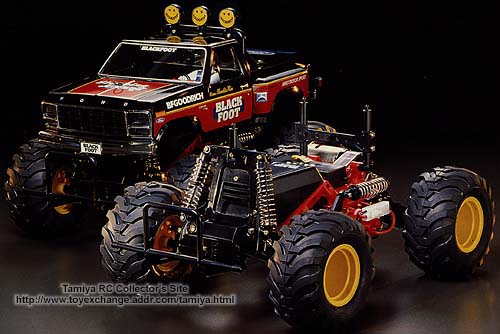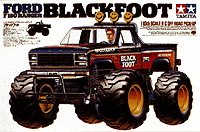Analysis of individual cars
The Blackfoot (58058)

The Blackfoot was kit number 58 from Tamiya. A 1/10 2WD, off-road monster truck, this was the kit that kick started the monster truck craze from Tamiya.
Specifications
- 1/10 scale off-road vehicle
- 2 wheel drive (rear drive with half shafts)
- Plastic frame chassis design
- Independent rear drive with trailing arm suspension
- 4 coil spring shocks (non-damped)
- RS-540 Mabuchi motor
- Realistic oversized monster tires
- ABS plastic body
Description
The Tamiya Blackfoot. Every single Tamiya R/C enthusiast knows this model well. An immensely popular truck from Tamiya, this is the one that started the R/C monster truck craze in the eighties.
Based on the sturdy Frog chassis, the truck featured a fully independent suspension all the way around. The front suspension arms and steering mechanism were beefed up to handle the forces incurred by having to drive the much larger (and heavier) tires.
In the rear, the mounting points for the shocks were modified to handle the longer shocks and also greater forces induced by the new monster tires. A cover was introduced to better protect the radio gear and speed control from the elements. A much better solution than the rubber balloon used on the Frog.
The rear drivetrain was taken directly from the Frog with no changes. Everything from the gearbox to the drive shafts were lifted directly from the older car. All of this was then topped of by a realistic Ford F-150 flareside truck body molded in ABS plastic.
The Blackfoot was one of those products that was "right place, right time" for Tamiya. Capitalizing on the monster truck craze that was taking off in North America and the inroads made by the Mauri Big Bear, the Blackfoot was an immediate sales success. A fairly simplistic design, it was easy to get up and running for the novice.
Further, by utilizing the Frog chassis, Tamiya kept developmental costs low and the Blackfoot carried a street price of under $100. An added advantage for the consumer was third party companies which already had a suite of performance parts for the car. Thorp, Hot Trick and CRP were just a few of the companies that were producing parts for the Frog, since most were a direct fit for the Blackfoot, a bit of repackaging was all that was needed to start selling Blackfoot performance parts!
Driving the car was a lot of fun. The car handles well, but would be a lot better had Tamiya included oil damped shocks with the Blackfoot. The standard coil springs allowed for a lot of bounce and rough off-road tracks tended to toss the car around quite a bit. On pavement though, it was really neat to see the rear end hunch down when power was applied.
The sheer popularity of the Blackfoot meant that Tamiya never could justify "retiring" it. Rather, they improved upon the original design introducing the Super Blackfoot and King Blackfoot into the market. The later models greatly improved on the suspension system front and rear.
Historical Significance
 In terms of Tamiya R/C kits, this is a must have. As you track Tamiya’s history in R/C you’ll see that there were a few cars that marked the "beginnings" of a new era in R/C. The Rough Rider, the Toyota Hilux and the HotShot just to name a few. The Blackfoot kicked off the Monster truck craze in R/C. Yes, the Mauri Big Bear came out first, but it was too small and too unreliable to really have a strong following. From the Blackfoot came the Varicom Grizzly, MRC Monster Truck and Kyosho Big Brute. All of which were launched in an effort to capture some of the market share that Tamiya had staked out.
In terms of Tamiya R/C kits, this is a must have. As you track Tamiya’s history in R/C you’ll see that there were a few cars that marked the "beginnings" of a new era in R/C. The Rough Rider, the Toyota Hilux and the HotShot just to name a few. The Blackfoot kicked off the Monster truck craze in R/C. Yes, the Mauri Big Bear came out first, but it was too small and too unreliable to really have a strong following. From the Blackfoot came the Varicom Grizzly, MRC Monster Truck and Kyosho Big Brute. All of which were launched in an effort to capture some of the market share that Tamiya had staked out.
A new in box kit is very difficult to find now, but they do come around. You can expect to pay $350 to $400 US for one of them. If you’re building for display purposes, you can pick up used ones fairly cheaply. Somewhere around $40 to $140 depending upon condition.
Additional Notes
Popularity is no indication of how robust the truck was. The Blackfoot had a few weak points. First was the rear drivetrain. The gearbox suffered from "separation slippage" where the gearbox halves would spread apart under torque and cause the bevel gears to slip and chatter. This was a problem with the Frog and the high loads imposed by the Blackfoot’s large tires only aggravated it. Thorp’s aftermarket ball-diff and dog bone kit was very popular amongst Blackfoot owners.
Other weak points include the rear suspension mounts, front bumper and mounts, and slop in the front suspension. All of these were addressed with aftermarket parts, but for the purist it’s important to check on the condition of the original pieces.
The bodies on these trucks tend to take a lot of abuse so check for stress fractures by the mounting points, condition of the front and rear windscreen and chrome trim pieces.
Rating
- Collectibility – 9 out of 10
- Fun to drive – 8 out of 10
- Parts availability – 6 out of 10
